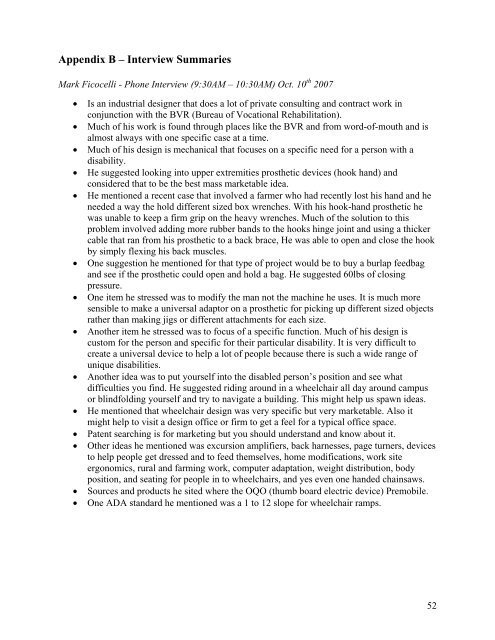Prosthetic Arm Force Reducer Team 1 – Halliday's ... - Ohio University
Prosthetic Arm Force Reducer Team 1 – Halliday's ... - Ohio University
Prosthetic Arm Force Reducer Team 1 – Halliday's ... - Ohio University
You also want an ePaper? Increase the reach of your titles
YUMPU automatically turns print PDFs into web optimized ePapers that Google loves.
Appendix B <strong>–</strong> Interview Summaries<br />
Mark Ficocelli - Phone Interview (9:30AM <strong>–</strong> 10:30AM) Oct. 10 th 2007<br />
• Is an industrial designer that does a lot of private consulting and contract work in<br />
conjunction with the BVR (Bureau of Vocational Rehabilitation).<br />
• Much of his work is found through places like the BVR and from word-of-mouth and is<br />
almost always with one specific case at a time.<br />
• Much of his design is mechanical that focuses on a specific need for a person with a<br />
disability.<br />
• He suggested looking into upper extremities prosthetic devices (hook hand) and<br />
considered that to be the best mass marketable idea.<br />
• He mentioned a recent case that involved a farmer who had recently lost his hand and he<br />
needed a way the hold different sized box wrenches. With his hook-hand prosthetic he<br />
was unable to keep a firm grip on the heavy wrenches. Much of the solution to this<br />
problem involved adding more rubber bands to the hooks hinge joint and using a thicker<br />
cable that ran from his prosthetic to a back brace, He was able to open and close the hook<br />
by simply flexing his back muscles.<br />
• One suggestion he mentioned for that type of project would be to buy a burlap feedbag<br />
and see if the prosthetic could open and hold a bag. He suggested 60lbs of closing<br />
pressure.<br />
• One item he stressed was to modify the man not the machine he uses. It is much more<br />
sensible to make a universal adaptor on a prosthetic for picking up different sized objects<br />
rather than making jigs or different attachments for each size.<br />
• Another item he stressed was to focus of a specific function. Much of his design is<br />
custom for the person and specific for their particular disability. It is very difficult to<br />
create a universal device to help a lot of people because there is such a wide range of<br />
unique disabilities.<br />
• Another idea was to put yourself into the disabled person’s position and see what<br />
difficulties you find. He suggested riding around in a wheelchair all day around campus<br />
or blindfolding yourself and try to navigate a building. This might help us spawn ideas.<br />
• He mentioned that wheelchair design was very specific but very marketable. Also it<br />
might help to visit a design office or firm to get a feel for a typical office space.<br />
• Patent searching is for marketing but you should understand and know about it.<br />
• Other ideas he mentioned was excursion amplifiers, back harnesses, page turners, devices<br />
to help people get dressed and to feed themselves, home modifications, work site<br />
ergonomics, rural and farming work, computer adaptation, weight distribution, body<br />
position, and seating for people in to wheelchairs, and yes even one handed chainsaws.<br />
• Sources and products he sited where the OQO (thumb board electric device) Premobile.<br />
• One ADA standard he mentioned was a 1 to 12 slope for wheelchair ramps.<br />
52

















